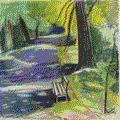
A representative of European Expressionism
 |
 |
 |
 |
 |
 |
“The activity of the artist must not exhaust itself in merely straining after effects. The artistic task arises from reflecting on what the abstraction of the world we live in, consists of. Only after solving this problem am I ready to paint abstract pictures.At the point where worrying about the fate of humanity ceases, a happy view of the world manifests itself; the art of art for its own sake.”
Éva Nagy: “Über mich und die Abstraktion der Welt” [About myself and the abstraction of the world], Wiener Kunsthefte, 7 August 1986
Colours and shapes – a kaleidoscope of introspection.
My mother’s pictures are characterised by a radiant energy of colours. A vital creative power.
Her works look inside, through and forward in a differentiated and boundlessly imaginative use of colour.
Impressions. Experiential worlds.
She was an authentic, convincing expressionist, an outstanding representative of the second wave of European Expressionism.
In a creative period that spanned almost 75 years, my mother produced well over 2,600 works and has in the process evolved from
naturalism to Impressionism and Expressionism to abstraction. She can be best described as an expressionist.
She did not belong to any school.
She was a sensitive, non-conformist artist who worked on her conclusive life’s work.
Over 2,600 works. Around 200 oil paintings and the rest drawings, pastels, water-colours and other graphics.
Probably for cost reasons, a lot of her works were done on paper with pastels, with watercolours, in ink and pencil, and as she worked she did a
lot of experimenting.
Canvases with blind frames and oil paints were too expensive. As a result, she sometimes also painted on unframed canvas and hardboard.
Her earlier works (in the 1960s) show agitation. Some are labyrinthine. Many of them show intertwined bodies.
The labyrinth looks as if it were impossible to disentangle; yet it is pervaded by a secret order and harmony.
In later works, this agitation can no longer be discerned. Many of these works suggest a blissful sense of security. They show part of the environment:
people, portraits, landscapes, trees, flowers and religious themes. The portraits, including her self-portraits, are impressive.
They are all introverted, pensive pictures of a highly sensitive painter. They affect the viewer who, through the unconscious, perceives the scenes and
themes of life presented.
She saw the world in colours, in movement and in dynamics. Her works offer the viewer a colourful dance of colours and shapes.
Her works contain expressions of truths which we all carry in our collective unconscious – in the Jungian sense – and which have an effect on
us as we look at the works. She created out of the imagination by opening the realms of the repressed.
That is why her works appeal to us, they have something to say.
This website has been set up in order to preserve the artistic legacy of this extraordinarily great artist and to make it
more accessible to experts and art lovers alike.
My mother’s art is, to a significant degree, esoteric and not easily accessible. One of the aims of this website is to establish her position in the
art world.
I hope the day will come when the public will get to know her work and appreciate it. This website is intended as a small contribution towards this.
Dr. Szabolcs Piskolti
Vienna, April 2004